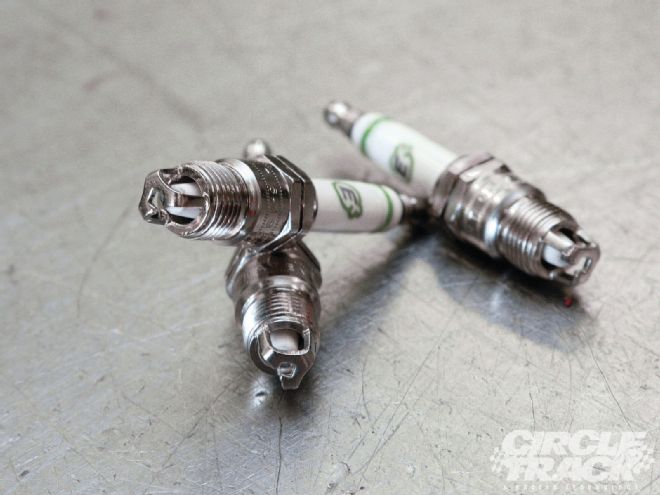
Yes, they're small, and they all practically look just alike, and even in the best of circumstances you're throwing them away and replacing them every few races, but spending a little time to make sure you have the best spark plugs for your race engine can make a big difference in performance.
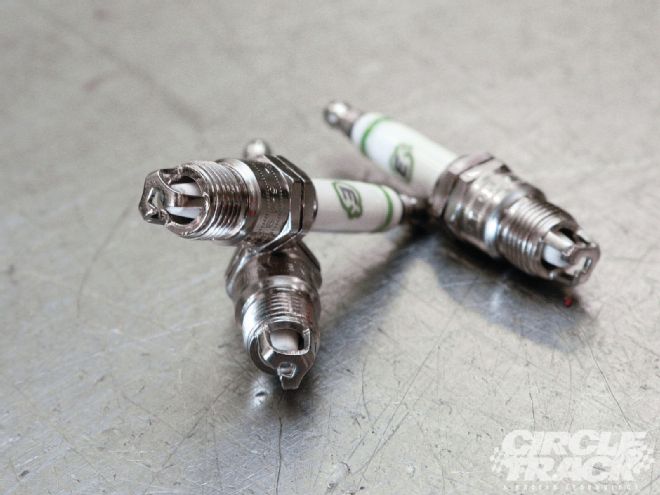 E3’s unique design is part of the evolution of the lowly spark plug to provide a powerful, consistent spark in even the most demanding conditions.
E3’s unique design is part of the evolution of the lowly spark plug to provide a powerful, consistent spark in even the most demanding conditions.
The reason why—like everything else in life—is both simple and complicated at the same time. The simple reason is a spark plug that can't reliably fire the air/fuel charge in the combustion chamber means power-robbing misfires. And a spark plug that's poorly chosen can also fail completely, resulting in a dead cylinder or worse, such as severe engine damage.
On the other hand, a plug that works as efficiently as possible with an engine package can help improve power. It all comes down to igniting that first bit of the air/fuel charge—commonly called the flame kernel. The larger that initial flame kernel, the more quickly the flame front will travel across the combustion chamber. It works much the same way a stronger ignition will allow you to open up the plug gaps which can improve power. A faster combustion promotes greater pressure inside the cylinder and that equals power.
Heat Ranges
When it comes to racing, choosing a spark plug within the correct heat range is vital. Heat range doesn't refer to the amount of spark output, but the amount of heat that a plug can dissipate from its core. A hot plug uses a large insulator in the nose area to increase the amount of area of contact between the ceramic insulator and the metal casing. The insulator in a colder plug may be constructed of a different material designed to help move heat.
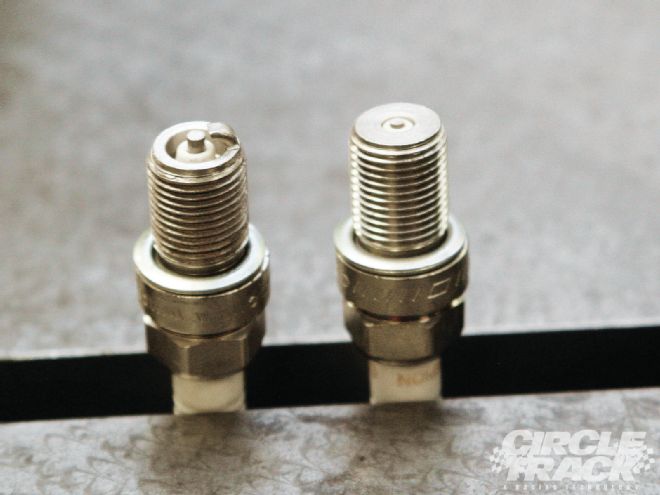 On the left is a traditional-style plug with a J-strap electrode. NASCAR Sprint Cup engine builders have developed issues with the electrode falling off due to vibrations in the combustion chamber, so some plug manufacturers, like Champion, came up with the surface gap design (right) that eliminates the J-strap electrode to eliminate the problem. The surface gap plug doesn’t help produce more power so it’sn’t recommended unless you’re experiencing electrode failures.
On the left is a traditional-style plug with a J-strap electrode. NASCAR Sprint Cup engine builders have developed issues with the electrode falling off due to vibrations in the combustion chamber, so some plug manufacturers, like Champion, came up with the surface gap design (right) that eliminates the J-strap electrode to eliminate the problem. The surface gap plug doesn’t help produce more power so it’sn’t recommended unless you’re experiencing electrode failures.
Also, it's not exactly the heat generated from the spark we're talking about. The plug is at ground zero of a small explosion every time the air/fuel mixture is ignited, and it's this heat from combustion that is absorbed by the plug and can really affect performance.
A cold plug can more efficiently move heat absorbed by the tip of the plug from combustion through the insulator and to the metal shell where it can then, in turn, be absorbed into the cylinder head where it can be negated by the water flowing through the coolant passages.
Finding the right heat range will be the difference between an engine that runs happy throughout the night, one that fouls plugs at the worst time or one that suffers from self-destructive detonation.
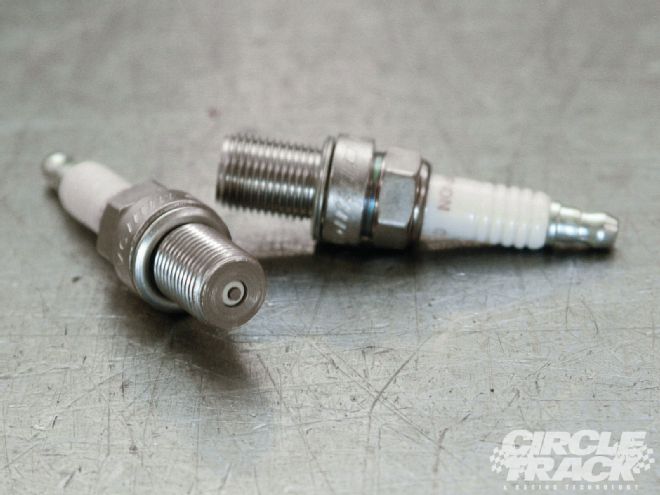 Here’s another look at the new surface gap plug. As you can see, the outer metal casing extends all the way to the tip of the plug and serves as the electrode. The spark is allowed to jump wherever it wants along the circle.
Here’s another look at the new surface gap plug. As you can see, the outer metal casing extends all the way to the tip of the plug and serves as the electrode. The spark is allowed to jump wherever it wants along the circle.
A problem with fouling spark plugs can come from running plugs that are too cold. This is because no race engine is perfectly efficient. Oil can make its way past the rings—especially the super thin, low tension rings that are currently so popular in racing—and into the combustion chambers. Likewise, some of the byproducts of combustion may remain in the chamber after the exhaust valve has closed, which can lead to carbon buildup.
Carbon buildup on the chamber walls, the piston top, or even the valves is no big deal, but carbon buildup on the spark plug can keep the electricity from flowing properly from the tip to the electrode. And in plain English that means no spark, and you've got a fouled plug.
That's why spark plugs are designed to operate within a certain temperature range while the engine is running that is hot enough to burn off any carbon that accumulates on the plug and essentially becomes self-cleaning. If the plug is too cold, it will wick away heat too fast and won't get hot enough to burn away any carbon buildup.
But that's not too often a problem in circle track racing where engine builders often recommend a plug on the cold end of the heat range. The trouble comes more often from running a plug that's too hot and heats up beyond the range it's designed to operate within. This can happen quite easily in performance engine packages like the race engine in your stock car.
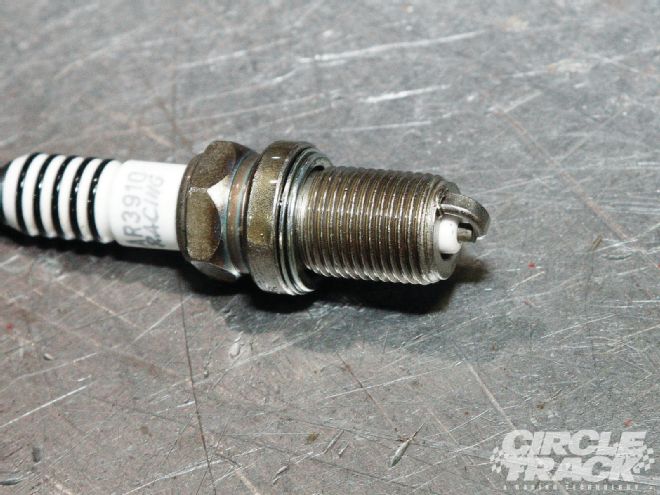 Typically, the J-strap electrode is welded to the metal casing. It’s along this weld that cracking—and eventually breakage—occurs in Cup motors. When the electrode falls off, it not only eliminates the spark but the electrode bouncing around inside the combustion chambers usually leads to damaged valves and scored cylinder walls.
Typically, the J-strap electrode is welded to the metal casing. It’s along this weld that cracking—and eventually breakage—occurs in Cup motors. When the electrode falls off, it not only eliminates the spark but the electrode bouncing around inside the combustion chambers usually leads to damaged valves and scored cylinder walls.
Engines in OEM vehicles don't typically see super-high rpm levels or run for extended durations under load and use a much colder plug. In fact, even drag race engines with much higher horsepower numbers will usually run a colder plug than a stock car because they are run for much shorter periods.
A plug that is too hot will pre-ignite the air/fuel charge in the combustion chamber before it actually fires. This happens because the high heat-range plug is too well insulated and the electrode gets hot enough to ignite the fuel without the help of a spark.
Pre-ignition leads to detonation, which is also called knock. It's deadly to an engine because it begins the combustion process too early and builds pressure in the cylinder while the crank is still trying to push the rod and piston up to TDC. The result is pounded bearings, broken pistons and bent rods—and various other problems. To avoid this, you have to find the spark plug that is hot enough to burn off the carbon buildup but not so hot that is causes detonation.
The Right Plug
Because the right plug will vary depending on many variables, including horsepower, combustion chamber design, cylinder head material, and other factors, we can't simply recommend a specific plug. Instead, you'll have to find what works best for you.
Begin by talking with your engine builder. If you're building your own engine, ask around at your track with people racing in your class. That should at least get you going in the right direction.
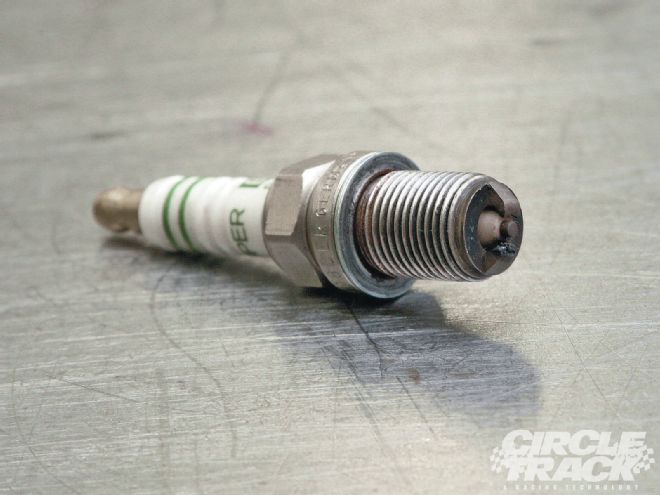 Here’s an example of a spark plug that was too hot for the application. You can see the damage to the lower electrode from excess heat in the plug. Had it not been caught in time it could have led to engine damage.
Here’s an example of a spark plug that was too hot for the application. You can see the damage to the lower electrode from excess heat in the plug. Had it not been caught in time it could have led to engine damage.
If you're starting completely from scratch, it's always best to err on the side of caution and choose a plug that is probably too cold rather than one that's potentially too hot. After all, the worst case scenario is a fouled plug rather than detonation and a broken engine. If the plug is too cold, move up one heat range at a time until the plugs stop fouling and instead has a slight gray coloring after a long run.
If you're confident you can detect pre-ignition early enough to avoid engine damage, keep working your way up the heat range ladder until you detect the start of detonation and then back off a step. This process is obviously best done during testing and not the night the night of a race.
Electrode Designs
One area where spark plugs have evolved greatly over the years is the electrode design. The traditional spark plug uses a "J-strap" design for the electrode that extends over the tip of the plug. These are the plugs that need to be gapped for proper clearance between the tip of the plug and the electrode.
But having the J-strap extend all the way over the end of the tip can actually shelter the spark from the air/fuel charge. As a result, most performance plugs now feature an electrode that is still the J-strap configuration but ends nearly lateral to the tip. Now the spark no longer extends directly up to the electrode, but out laterally. This exposes more of the spark to the air/fuel charge for a larger flame kernel which can help power. In high compression engines it's also more difficult to ignite the air/fuel charge and this design—along with a high-power ignition—helps improve firing efficiency.
This style also has a second advantage. Because the electrode doesn't extend all the way over the tip of the plug, it's also shorter. Now, plug designers can extend the plug so that the tip extends farther into the combustion chamber which also helps improve combustion and—you guessed it—power.
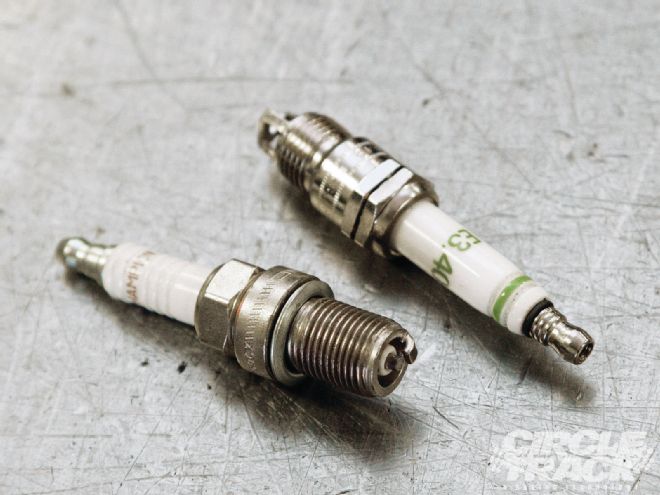 Because they have different expansion rates, whether you’re running aluminum or cast iron cylinder heads will affect the correct plug design. Aluminum heads usually use a spark plug with a gasket (foreground) to help seal between the steel of the plug and the aluminum head. Iron heads use a plug (background) without a gasket.
Because they have different expansion rates, whether you’re running aluminum or cast iron cylinder heads will affect the correct plug design. Aluminum heads usually use a spark plug with a gasket (foreground) to help seal between the steel of the plug and the aluminum head. Iron heads use a plug (background) without a gasket.
But continued advancement in stock car racing engines has uncovered a flaw in traditional plugs with a J-strap electrode. In NASCAR's top touring series—Cup, Nationwide, and Truck—engine builders have been experiencing problems with the J-strap, which is welded on to the thread metal case, cracking and breaking off.
Some believe it's a product of the vibrations set up by very intense valvetrain movements and high rpm levels maintained lap after lap. Others think it's a product of very efficient combustion causing damaging pressure waves that can literally shake the J-strap loose.
Either way, it's not specifically a matter of horsepower because unlimited Dirt Late Model motors that produce equivalent power don't seem to have the same problems.
As a result, plug manufacturers, like Champion, have produced what they call "surface gap" plugs. These don't have a single electrode at all and instead produce a spark that arcs from the tip of the plug to the metal casing. This design doesn't typically produce more power than traditional plugs using a J-strap design, so they are only recommended for applications where strap failure is a problem. But as engine designs in the lower levels of stock car racing continue to evolve, these plugs may become more prevalent by necessity.
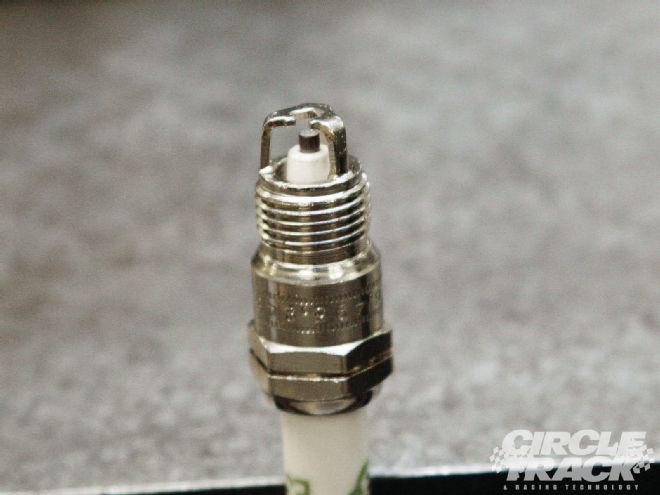 The E3 spark plug uses a unique electrode design that provides multiple points for the spark to jump to. The idea is that a spark jumps most readily from one sharp point to another. Having multiple points on the electrode for the spark to jump to helps the plug to operate at maximum efficiency longer.
The E3 spark plug uses a unique electrode design that provides multiple points for the spark to jump to. The idea is that a spark jumps most readily from one sharp point to another. Having multiple points on the electrode for the spark to jump to helps the plug to operate at maximum efficiency longer.
The New Kid on the Block
At the other end of the spectrum from the surface gap plug design are the plug designs from a relatively new manufacturer, E3. Instead of a traditional J-strap, E3 plugs feature a three-pronged structure that serves as the electrode.
The design serves a couple of purposes, according to E3. First, E3's engineers say that their research shows a traditional plug loses some power relatively quickly as the electrode wears down from near constant electrical current.
Electricity flows most easily across a gap from one sharp edge to another. The E3 design creates multiple sharp edges in a complex electrode design so that the spark plug operates at premium efficiency for a longer amount of time. The electrode structure also has an opening directly above the plug, so even though there appears to be a lot of material for the electrode, it's still easy for the flame kernel to propagate throughout the rest of the combustion chamber.
We also suspect that the extra mass of the E3 electrode will be more resistant to breakage than traditional J-strap designs, and may provide a good option in applications where broken plugs are a problem. This is something we'll definitely have to look into further in another issue.